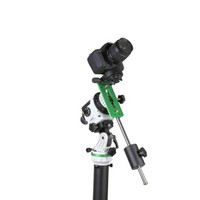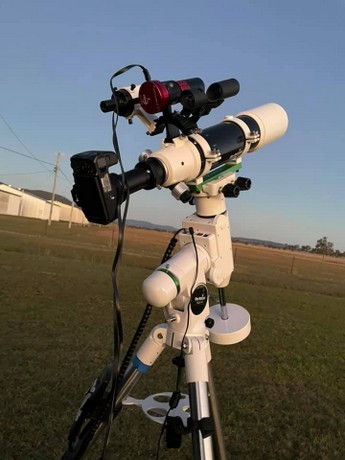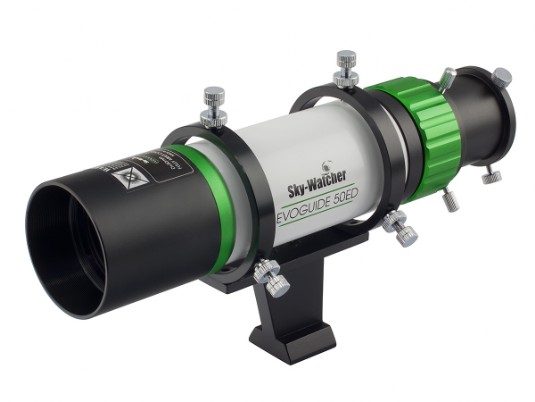Telescopes
Gear
More on equipment -as much or as little as you like.
Other cameras, lenses and filters will certainly help add to the variations of shots you can take.
However, if you want to invest more time, energy and of course money, there is another another aspect for deeper sky photos.
The key when you take a night photograph, is to collect as much data (or photons) as possible, without star trails.
A 10 or 20 second photo maybe okay but a photo that took 2-5 minutes is better, if you can stop star trailing.
Star trails occur in astro-photography when the camera captures the apparent movement of stars across the sky due to the Earth's rotation. These trails appear as streaks or arcs instead of sharp points of light. While star trails can be a creative effect, for certain types of astro-photography where sharp star images are desired, preventing them is crucial.
In this area we talk about more items like Skywatcher Star Adventurer (SA) and Equatorial Mounts (EQ).
We also touch on other types of cameras, and the different types of telescopes.
Skywatcher Star Adventurer
 The Skywatcher Star Adventurer is a portable mount designed for astrophotography and time-lapse photography. It's a compact and versatile tracking platform that allows cameras to follow the apparent motion of the stars across the night sky.
The Skywatcher Star Adventurer is a portable mount designed for astrophotography and time-lapse photography. It's a compact and versatile tracking platform that allows cameras to follow the apparent motion of the stars across the night sky.Here's what you can do with a Star Adventurer:
Astro-photography: It helps capture long-exposure images of celestial objects without star trailing. By compensating for the Earth's rotation, the Star Adventurer enables your camera to track the stars, allowing for sharper images of stars, galaxies, and nebulae.
Time-Lapse Photography: You can create stunning time-lapse sequences of the night sky by mounting your camera on the Star Adventurer. It ensures that your camera smoothly tracks the stars throughout the duration of your time-lapse.
Panoramic Photography: It aids in creating panoramic shots of the Milky Way or other parts of the night sky by precisely moving the camera as needed.
The Star Adventurer is popular among astro-photographers and photographers who require a portable and relatively easy-to-use tracking mount for capturing long-exposure images of the night sky. Its compact size and versatility make it a handy tool for anyone interested in astro-photography or capturing the beauty of the cosmos.
The big brother to this is an 'Equatoral Mount', a little similar to the 'Star Adventurer' but more for a telescope.
An equatorial mount is a type of telescope or camera mount designed to track the apparent motion of celestial objects in the sky. Its primary purpose is to compensate for the Earth's rotation, allowing the mounted instrument to follow the stars as they appear to move across the sky.
Here's how an equatorial mount works and what it does:
Tracking Celestial Objects: The Earth rotates on its axis, causing celestial objects to appear to move across the sky. An equatorial mount is aligned with the Earth's axis, typically with one axis tilted to match the observer's latitude. This alignment allows the mount to move in sync with the rotation of the Earth.
Following Celestial Motion: By aligning one axis of the mount with the celestial pole (either the North or South Pole), the mount compensates for the apparent motion of the stars. As the Earth rotates, the equatorial mount can be adjusted to move along a single axis (called the right ascension axis) at the same rate but in the opposite direction of the Earth's rotation. This movement effectively tracks celestial objects across the sky.
Facilitating Long-Exposure Photography: Equatorial mounts are essential for long-exposure astro-photography. By keeping the camera or telescope fixed on a celestial object, they prevent star trails, allowing for clear and sharp images of stars, planets, galaxies, and other deep-sky objects.
Equatorial mounts come in various designs, including German equatorial mounts and fork mounts, but they all share the common functionality of aligning with the celestial coordinate system to track the apparent motion of celestial bodies.
Many of these mounts like the HEQ5, and EQ6-r have over 40,000 objects pre-programmed into them and include a night sky Tour of objects that should be able to be seen in your location on that night.
TELESCOPES
Below, An 80mm Refractor Telescope on a HEQ5 Pro mount with a Nikon DX5500 camera attached

In general, there are three basic types of telescopes.
1. Refractor Telescopes: These use lenses to gather and focus light. They're great for viewing planets and the moon because they provide sharp images with high contrast. However, they tend to be more expensive for larger apertures.
They are somewhat similar to a camera lens as far as how they work, and can even connect directly to your camera with a small 'T-Ring' adapter.
2. Reflector Telescopes: These use mirrors to collect and focus light. They're excellent for viewing faint objects like nebulas due to their ability to gather a lot of light. They're also good for planetary observation and can be more affordable than refractors for larger apertures.
3. Compound Telescopes: These combine lenses and mirrors, like the Schmidt-Cassegrain or Maksutov-Cassegrain designs. They offer a good balance between the two types and are versatile for both planetary and deep-sky (like nebulas) observation. They're also quite popular for astro-photography.
Photographing planets, the moon, and nebulas:
Planets and Moon: Refractor telescopes are great for capturing sharp and detailed images of planets and the moon due to their ability to provide high contrast and clear views.
Nebulas: Reflectors or compound telescopes are better suited for capturing faint objects like nebulas due to their light-gathering ability. Reflectors can gather more light, making them great for deep-sky photography.
For astro-photography in general, especially for beginners, compound telescopes like Schmidt-Cassegrain designs are often recommended. They offer a good balance between ease of use, portability, and versatility for capturing both planetary and deep-sky objects.
Below: Left- 250 mm Dobsonian mounted, Newtonian (Reflector) telescope. A very good scope for beginners in planetary observation and general star gazing.
Right- 50mm Skywatcher Evoguide



